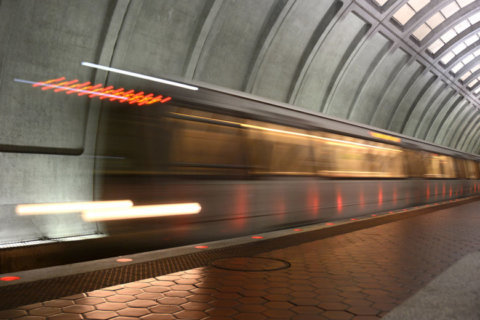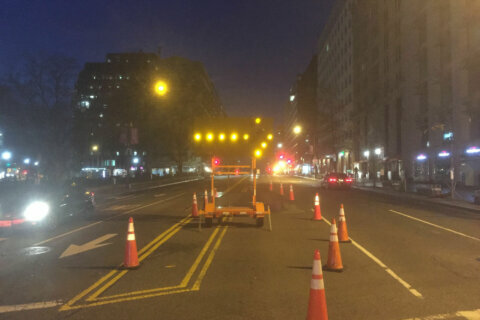Metro is providing additional detail and estimates on its plans to cut or reduce service on more than 40 bus lines and to eliminate some early-morning weekday trains, but add some bus service on other lines and restore some late-night hours cut a few years ago.
The Metro Board is set to discuss the proposals Thursday, then set public hearings over the next few weeks on the $2.09 billion operating budget plan for the year starting July 1, as well as the related $1.875 billion capital budget.
Last month, the board delayed action pending additional information from Metro staff, which Metro now believes has delayed the usual adoption of the budget from March to April. That delay means Metro could be cutting it close with some federal grant applications that must be processed before the budget year begins July 1.
Bus, rail cuts
Under the new budget details, Metro stands by the proposed bus cuts WTOP revealed in December that would eliminate all or part of 29 lines and cut service frequencies or hours on 17 other lines.
Metro projects the cuts would net $26.6 million in savings after accounting for a loss of about 5 million trips and $7.4 million in fares per year. Metro’s calculations of ridership losses do not include the trips that it expects people will still take on other transit services, even using less convenient options.
Metro also expects $3.6 million in net savings by running trains less frequently on all lines between 5 a.m. and 6 a.m. on weekdays and by eliminating some one-way Green and Orange Line trains that run in the morning and afternoon.
Fare change details
Among fare changes proposed to start this summer, Metro projects that an increase in the base rush-hour fare by 10 cents, to $2.35, would bring in $5.6 million more while cutting 1.8 million trips per year; increasing some per-mile trip fees would also raise $5.6 million while cutting 200,000 trips.
Raising the cap on the longest trip costs from $6 to $7 is projected to raise $3.9 million, while cutting about 100,000 trips. Cutting weekend rail fares to $2 would cost Metro $11.3 million but could add 1.3 million trips, Metro believes.
The Metro Board proposes looking at raising the base fare even more for short trips. It would raise more money but cut far more trips, Metro staff found, while raising long-distance fares less would not keep more riders but simply would leave Metro with less money.
If Metro switches to a weekend flat fare, staff are concerned about anything above $2, because that would represent an increase in fares for some trips. Today, 51% of weekend rail riders pay less than $2.50 already, and 63% pay less than $2.75. Metro is optimistic about possible cheaper unlimited ride weekend rail and bus passes.
Metro staff are unsure about the potential ridership impact of an extra $1 fee for trips to or from the Dulles Airport station due to open this fall. They’re also concerned about potentially returning to peak fares after midnight on weekends, and they have serious concerns about a Maryland proposal to raise fares on limited-stop Metrobus routes from $2 to $3.
An additional 25 cent charge for using cash on Metrobus would cut 600,000 trips while raising about $800,000, and making bus rides free when connecting to or from a Metro train would cost Metro $19 million but add an estimated 3 million trips.
Where service could improve
Proposals to run 14 bus lines more frequently at times on the weekend are projected to cost $3.1 million while adding about 700,000 trips per year. Improving limited-stop Metrobus service on four lines is expected to cost about $2.6 million while adding 800,000 trips per year.
Running trains more frequently on Sundays is expected to cost about $2.5 million, while adding 500,000 trips per year, and returning Metro to midnight closings Monday through Thursday and partially restoring Friday and Saturday night service to close at 2 a.m. would cost about $3.8 million while adding an estimated 400,000 trips per year.
Metro plans to continue its limited late-night subsidies for certain Lyft trips after the system closes. Metro also plans to spend $2.5 million on improving customer service, but has no projected ridership increase associated with that line item.
In all, the service changes are projected to save Metro about $19.9 million, minus about $4.1 million in lost fares, for a subsidy savings of about $15.9 million largely due to the major bus service cuts.
MetroAccess, Silver Line costs
Metro does plan to spend more in this budget overall, though, due to factors such as the launch of the Silver Line extension to Loudoun County, safety mandates and paratransit service growth.
Metro promises not to cut the MetroAccess service area until at least Dec. 31, even though proposed Metrobus cuts could allow the agency to scale back paratransit service.
The Silver Line extension requires hiring and training 337 full-time employees, or their equivalents, so the Metro Board plans to approve the start of the hiring process, as well as additional money, in next year’s budget.
The new positions include 65 train operators; 25 station managers; eight elevator and escalator journeymen; 30 Metro Transit Police officers; 48 superintendents and administrative staff; 60 track workers; nine rail operations controllers; and 86 engineers, technicians or mechanics.
Police officers have the longest training time, followed by rail controllers, train operators and station managers.
Metro is planning for a fall 2020 opening of the Silver Line extension to Dulles International Airport and Ashburn, but that timing could shift, because the contractors building the line for the Metropolitan Washington Airports Authority are still working to resolve construction problems and delays.
The ramp-up will require $60.1 million over the next six months, plus $30 million in the new budget after July 1.
If there is a delay, Metro could slow the ramp-up costs. While that is expected to cost $60.1 million in the next six months, some of that money will come from Metro savings, so local governments expect to contribute only up to $23.5 million more between now and July.
If service launches in fall 2020, Metro expects operations will cost about $90.1 million through July 2021, with a slow ridership increase along the new line that would bring in about $5 million in fares. Metro expects about 750,000 entries and exits per year at the Dulles station, for example.
8-car trains
The Silver Line launch and final delivery of new 7000 Series trains will also help Metro continue to grow the number of full-length eight-car trains in the system.
Today, Green and Yellow Line trains are all supposed to have eight cars at rush hour, while other lines are scheduled to have 50–70% eight-car trains, for an overall average of 68%. At the opening of the Silver Line and the new Dulles rail yard, Metro expects to reach 80% of trains scheduled with all eight cars.
Metro’s progress on that front would be limited if it restored more frequent service, because Metro’s power system upgrades have yet to be completed.






